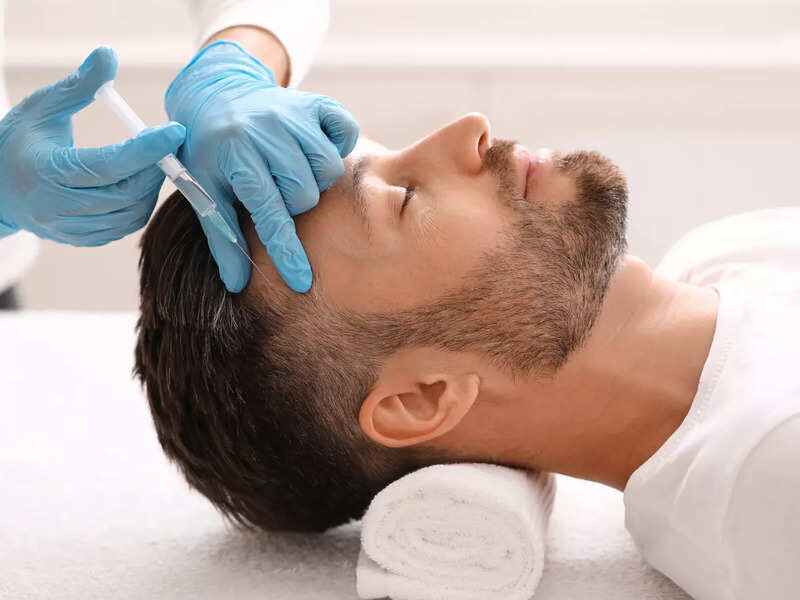
Platelet Rich Plasma Therapy (PRP)
Platelet-rich plasma (PRP) (syn. autologous platelet gel, plasma-rich growth factors and platelet- concentrated plasma) means “abundant platelets that are concentrated into a small volume of plasma.” It contains an effective concentration of multiple fundamental growth factors (GFs) that promote tissue repair and regeneration.
PRP is 3-step procedure that involves having your blood:
- Drawn from your arm
- Placed into a machine that separates the platelets from the rest of your blood
- Re-injected into you (only the part of your blood that contains a high concentration of platelets).
The unearthing of the role of PRP in wound healing and repair paved the way for its utilization in various fields of medicine and surgery including dentistry, maxillofacial surgery, orthopedic trauma and sports injuries, cardiovascular, gastrointestinal, and plastic surgery. In dermatology its primarily used for hair loss and skin rejuvenation.
PRP for hair loss
Studies on platelet-rich plasma and the use of PRP injections to remedy hair loss is relatively new to the world of dermatology. It has shown great potential in regenerative therapies including hair loss. It works by stimulating specialized population of cells named dermal papilla cells, which play a critical role in hair growth.
Who Can Benefit from PRP Injections?
PRP injections can benefit a wider range of people.
- Both men and women. Male balding and hair thinning is talked about extensively, but women do not often get the same benefit of widespread information. The fact is that women can lose hair, too, due to several different factors.
- Those suffering from androgenic alopecia or other forms of alopecia. This is also known as male/female pattern baldness.
- Those suffering from hair loss due to high stress levels. Since this condition is not chronic, it can be treated rather easily.
- Those who have recently experienced hair loss. The more recent the hair loss occurred, the better your chances are of fixing it before it is too late for PRP injections.
- Those with thinning or balding hair, but not completely bald people. PRP injections are meant to thicken, strengthen, and grow hair from follicles that are still functioning.
PRP injections help to restore the existing hair and also help the other hair roots to grow. It is always better to start early than late in cases of extreme hair fall because only a limited amount of hair can be restored. While it may sound scary, there are no major side-effects to this therapy. Mild discomfort during the therapy and slight pain during the injection can be present. Side effects on the skin with PRP injections apart from the above mentioned can include mild bruising and redness. The average width of the hair improves with PRP, which improves overall hair thickness. A minimum of 3 sessions in an interval of four weeks is required to see appreciable results. One can continue the treatment up to 8-10 sessions. Maintenance sessions can be done thereafter at intervals of 6-9 months.
Vampire facial
Colloquially termed “vampire” treatments, PRP injected into the skin or used after microneedling (a technique that uses small needles to create microscopic skin wounds) help to improve skin texture and appearance. Skin aging results in wrinkles, coarseness, pigmentation, and loose skin. When platelet-rich plasma is reintroduced to skin on its own through a non-invasive procedure, cell turnover is stimulated, and in turn, collagen and elastin production is ramped up for a plumper, tighter, and smoother skin. The whole process takes about 45 minutes and mild side effects including some redness, burning etc. are usually transient.
Those with premature wrinkles, high levels of sun damage, or anyone who desires a fresher, more even-toned complexion are ideal candidates for the vampire facial. However, if you have a history of blood diseases, including clotting or bleeding disorders, you should avoid PRP treatments.
Conclusion
With the unveiling of its mechanisms and clinical efficacy in recent years, PRP seems to be a promising therapeutic modality in the field of dermatology. PRP, used alone or in combination with other therapies, showed beneficial effects in terms of cosmetic improvements and for some skin diseases. It is a safe, out-patient procedure with minimal downtime and can be used in a wide range of people for alopecia (hair loss) and skin rejuvenation. As the patient’s own blood is used in the procedure it involves minimal to no risk.
If you are interested in learning more about PRP therapy, please click here and send a query to Alovia Clinic, or reach out to our expert Dr. Naren Parkash